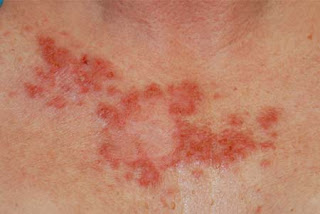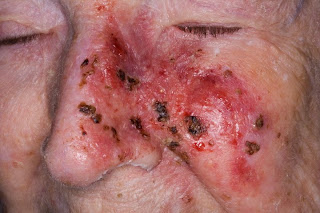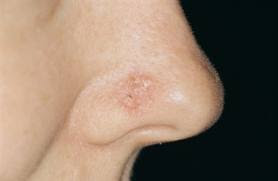 · Ongoing exposure to UV radiation, particularly if you're unprotected at the time, puts you at much higher risk for this condition. There are many potential sources of UV radiation that you may not be aware of, too. Sunlight is perhaps the largest source of this type of radiation, but UV lamps, some welding equipment, and even phototherapy lamps can also place you in areas where the UV radiation occurs at a much higher concentration.
· Ongoing exposure to UV radiation, particularly if you're unprotected at the time, puts you at much higher risk for this condition. There are many potential sources of UV radiation that you may not be aware of, too. Sunlight is perhaps the largest source of this type of radiation, but UV lamps, some welding equipment, and even phototherapy lamps can also place you in areas where the UV radiation occurs at a much higher concentration.· If you have a fair complexion, you're at a much higher risk of skin cancer. Colorado Springs residents who don't have naturally darker skin may find themselves coming down with this condition at much higher rates than those with other pigmentations. While this isn't a primary risk factor, it's certainly something to be aware of every time you go out in the sun.
· Some jobs may put you at greater risk of this condition. If your job involves coal tar or pitch as well as arsenic compounds, radium, or even creosote, skin cancer is a very real possibility, and your employer should provide you ongoing screenings to ensure you're exposure rates haven't been too high.
· Childhood may also play a role in skin cancer. Colorado Springs adults who experienced sunburns as a child are far more likely to be diagnosed with one of the many forms of skin cancer than others are. Because the UV radiation can take some time to build up in your system, by the time you reach adulthood, you could be looking at some very real consequences for serious burns as a child.
· Individuals with multiple moles are also considered to be in a high risk category. Keeping an eye on every mole you have for changes is essential, as it can help you notify health professionals in plenty of time.
Whether you're at greater risk than others or you've just noticed a change in your skin that you're suddenly concerned about, contacting the right professional help is an absolute must to diagnose and treat this condition early.
Do you live in Colorado Springs, CO? Get your FREE consumer's report, "How to Find a Great Dermatologist in Colorado Springs: SKIN CANCER EDITION" and get the facts. Go to http://www.ColoradoSpringsSkinCancerGuide.com to claim your free report written only for Colorado Springs residents. Don't take your health for granted, visit now! http://www.ColoradoSpringsSkinCancerGuide.com
Article Source: http://EzineArticles.com/?expert=Palyn_P


 Skin cancer often takes the form of a sore or a pimple that won't heal, typically appearing as an abnormal growth on the skin. The
Skin cancer often takes the form of a sore or a pimple that won't heal, typically appearing as an abnormal growth on the skin. The 


 If you find a growth on your skin that suddenly appears or changes in its size you ought to have it checked out by your GP. This is particularly true if it is translucent, tan, pearly, brown, black or has multiple colors. This could be one of the
If you find a growth on your skin that suddenly appears or changes in its size you ought to have it checked out by your GP. This is particularly true if it is translucent, tan, pearly, brown, black or has multiple colors. This could be one of the  Like most other cancers, the quicker that skin cancer is detected and treated the better. Therefore, it is essential to examine your skin periodically for any new or unusual blemishes, moles, freckles or sores. One of the earliest
Like most other cancers, the quicker that skin cancer is detected and treated the better. Therefore, it is essential to examine your skin periodically for any new or unusual blemishes, moles, freckles or sores. One of the earliest  The Five signs:
The Five signs: Experts firmly believe many of these cancers are sun related, which means there are things you can do, even in the summer or at the beach, to protect yourself and those you love from this most common of cancers.
Experts firmly believe many of these cancers are sun related, which means there are things you can do, even in the summer or at the beach, to protect yourself and those you love from this most common of cancers.


 An Australian study out of the University of Queensland attempted to address this challenge by looking at twin pairs where one twin had been diagnosed with melanoma. Using 125 twin pairs (27 sets of identical twins, 98 sets of fraternal twins) the researchers found that having an identical twin who had melanoma increased a person's own risk of developing the same disease nearly ten fold.
An Australian study out of the University of Queensland attempted to address this challenge by looking at twin pairs where one twin had been diagnosed with melanoma. Using 125 twin pairs (27 sets of identical twins, 98 sets of fraternal twins) the researchers found that having an identical twin who had melanoma increased a person's own risk of developing the same disease nearly ten fold. There are two main risk factors for skin cancer. The first is sun exposure. People who live in sunny areas, people who are continuously exposed to the sunlight, or people who were badly sunburned as children are all at a higher risk. Fair-skinned people are high risk as well. It is important that everyone be protected when they go out in the sun. Sunscreen should be worn all the time, even if the day seems cloudy or not that hot. This is especially important for those with fair skin and for children.
There are two main risk factors for skin cancer. The first is sun exposure. People who live in sunny areas, people who are continuously exposed to the sunlight, or people who were badly sunburned as children are all at a higher risk. Fair-skinned people are high risk as well. It is important that everyone be protected when they go out in the sun. Sunscreen should be worn all the time, even if the day seems cloudy or not that hot. This is especially important for those with fair skin and for children.  What causes Skin Cancer?
What causes Skin Cancer? I wish my aunt realized the dangers before skin cancer cut her life short.
I wish my aunt realized the dangers before skin cancer cut her life short.